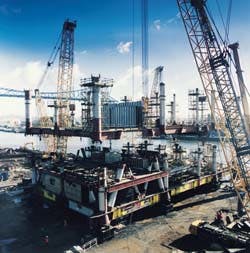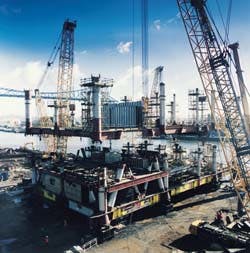Offshore Europe
Jeremy Beckman
London
The production deck for the Britannia platform was fitted recently to the main production deck by fabricator Trafalagar John Brown in Teesside, UK. Britannia is a far longer-term priority now for joint operator Chevron than the Ninian Field.
UKCS output not matched by exploration strike rate
UK oil and gas production hit new heights in 1995, according to the Department of Trade and Industry's annual Brown Book review. Oil and gas output totaled 130 million tons and 75 bcm, 3 metric tons and 5 bcf up on 1994 levels. Fields in production rose from 149 to 163, with a record new 26 offshore field developments approved.
Investment in the sector climbed 19% to ٢.2 billion. Total income of companies involved was 㾾 billion, including a new high of ٢ billion from the gas production sector.
There was also a record for new development wells drilled offshore - 244 (including 42 sidetracks), up from 202 the previous year. Sixty exploration wells were spudded, but yields were unspectacular, mainly proving up further gas close to existing installations.
Industry and Energy minister Tim Eggar claimed that improved recovery technology applied to mature fields would help prolong UK oil and gas consumption at present rates for over 50 years. But the continuing lack of discoveries may lead to a drift by the majors to more promising arenas.
The DTI has identified 146 licensed UK blocks where no work has been performed by the operator for six years. Eggar said he wanted that number reduced to single figures, which would mean certain blocks being handed back if no activity were forthcoming. "We need to increase the level of activity in older acreage," he said, pointing to the Gulf of Mexico as an example of what could be achieved in reviving a mature province.
There are numerous independents that would be keen to move in to the fallow UK acreage; the DTI has also pushed their cause through a new code of practice aimed at opening up UK offshore infrastructure to outsiders.
British oil output will get a 60,000 b/d lift late this year, when BP's newly onstream Harding Field builds to maximum production. Gas production this year has just been boosted by Amoco's southern sector Beaufort Field, which will produce at 30 million cf/d for the next four years through an extended reach well drilled from the Bessemer platform. Amoco has numerous other gas prospects nearby which could come into play, especially now that it has applied for DTI consent to build a gas-fired power station at Great Yarmouth.
Phillips has announced a further gas accumulation in J-Block, via a well drilled through the Judy Field subsea template. It was completed and tested over an interval of 110 ft in Triassic sandstones, flowing at 20 million cf/d and 3,800 bbl of condensate per day on a 36/64-in. choke. The area accessed was a downthrown fault block at a greater depth, higher pressures and temperatures than the main Judy wells.
Further appraisal wells could follow from the platform, with production possible to coincide with completion of the J-block gas reinjection scheme. However, Enron, which inadvertently initiated this project through its decision to postpone deliveries of Judy gas, is now trying to prevent it through a court injunction. It claims the scheme would jeopardize future supplies from Judy/Joanne. This is being contested by the operators of the CATS transmission system that would handle the fields' gas.
Danish development prospects advance
One of Denmark's oldest dormant offshore reservoirs, South Arne, has finally been declared commercial, 32 years after its discovery by the DUC. Current operator Amerada Hess is still cagey about the size of the oil and gas found, but is understood to be considering either an FPSO or wellhead platform with storage for the development. The export outlet is also undecided, but could conceivably head to the Tyra facilities via the Svend pipeline.
Another FPSO is off the cards for Statoil's 38 million bbl Lulita oilfield that also dips into Norwegian sector 3/7 block. Maersk's Harald processing facilities to the south will now be upgraded to handle the extra crude, again via an existing pipeline, following appraisal of a horizontal well producer planned for later this year.
Halten Bank gas discovery uprated
Last year's gas condensate discovery by Saga in Halten Bank Block 6406/2 has been confirmed as one of Norway's major new fields. Results of the recently completed appraisal well 6406/2-2 suggest 70-120 million cubic meters oil equivalent (mcmoe) may be recoverable, compared to the initial estimate of 50-100 mcmoe.
Semisub Ross Rig drilled the latest well in 272 meters of water to a T/D of 5,327 meters, terminating in the Early Jurassic. As with the first well, gas and condensate were in evidence at numerous levels, with the best pay zone delivering 1.04 million cu meters of gas and 575 cu meters of condensate through a 27mm choke.
Drilling was completed in 72 days, 32 days ahead of schedule and 30% under budget at NKr99 million. A further structure to the west will be drilled later this year.
Saga has also strengthened its exploration acreage close to its Varg development through buying up Conoco's stakes in nearby licences. Varg is a marginal oil and gasfield recently sanctioned for development through a production vessel and wellhead platform. Any nearby finds would enhance production longevity, which at this stage remains uncertain.
Mature fields win service extension
Squeezing new life out of old fields is on the minds of operators on the two main sides of the North Sea divide. In Norway, Phillips is now suggesting that its slowly sinking Ekofisk 2/4A and 2/4B platforms could stay in production for years to come.
They had been threatened with a closedown in 1998, but Phillips claims the cut-off level for safe subsidence - respectively 4.1 and 4.5 meters - will not be reached until the next century. Keeping them going would maintain oil production levels, avoiding the need for a mobile rig to drill replacement wells from the 2/4-X platform under the Ekofisk IIa redevelopment.
Amoco's Valhall Field also got a new lease of life via a new wellhead platform, installed in April and due onstream last month. There are slots for up to 19 wells accommodating a further 82 million bbl of oil and 4.4 bcm of gas from the field as well as third party production. Valhall production will surge from 40,000 b/d to 125,000 b/d by 1998.
Copyright 1996 Offshore. All Rights Reserved.

